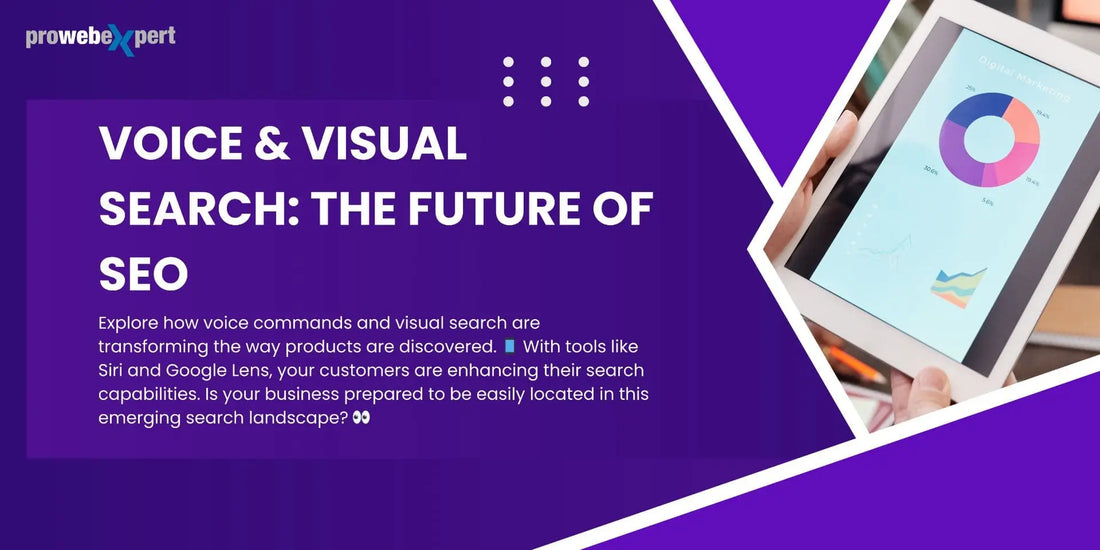
Voice & Visual Search Optimization: The Future of SEO and Product Discovery
Share
In the ever-changing digital world, how customers search for information is evolving faster than ever. The days of typing a few keywords into a search box are fading. Today, people are speaking to devices like Siri, Alexa, and Google Assistant, or using their camera to search visually on platforms like Google Lens and Pinterest Lens.
This shift towards voice and visual search is reshaping SEO strategies and product discovery for businesses. If you’re not optimizing for these technologies now, you could be invisible to a huge segment of future customers.
What is Voice Search Optimization?
Voice search optimization is the process of tailoring your website content so it can easily be found through voice commands on smartphones, smart speakers, and AI assistants.
Example:
Instead of typing “best coffee shop near me”, a user might say:
“Hey Siri, where’s the best coffee shop nearby?”
Voice searches are longer, conversational, and question-based compared to traditional text searches.
Why Voice Search Matters
-
Faster Growth – Over 50% of all searches are now voice-based.
-
Mobile First – People often use voice while on the go, making local SEO critical.
-
Smart Devices Boom – The sales of Alexa, Google Home, and Apple HomePod are rising yearly.
How to Optimize for Voice Search
-
Focus on Conversational Keywords
-
People speak naturally, so target long-tail, question-based keywords.
-
Example: Instead of “Shopify SEO,” target “How do I improve my Shopify SEO ranking?”
-
Use Featured Snippets
-
Voice assistants frequently retrieve responses from Google’s “Position Zero.””
-
Formulate straightforward and brief responses to frequently asked questions within your area of expertise.
-
Improve Local SEO
-
Individuals using voice search frequently seek results that include "near me."
-
Claim and optimize your Google Business Profile.
-
Ensure NAP (Name, Address, Phone) details are consistent across platforms.
-
Make Your Site Mobile-Friendly
-
Voice search predominantly occurs on mobile devices, making quick loading times and a responsive layout crucial.
What is Visual Search Optimization?
Visual search allows users to upload an image or use their camera to find similar products, information, or ideas online.
Example:
A shopper sees a beautiful lamp in a café. Instead of typing “gold modern lamp,” they open Google Lens, snap a photo, and instantly find stores selling that same or similar lamp.
Why Visual Search Matters
-
Highly Intent-Driven – If a user searches via image, they’re already interested in buying.
-
Rising Adoption – Platforms like Pinterest Lens report over 600 million visual searches per month.
-
Better Product Discovery – Visual search removes language barriers—perfect for global e-commerce.
How to Optimize for Visual Search
-
Use High-Quality, Original Images
-
Sharp and distinct product images improve AI's ability to identify objects more effectively.
-
Use multiple angles and lifestyle shots.
-
Add Descriptive Alt Text & File Names
-
Instead of “IMG1234.jpg,” use “blue-leather-handbag.jpg”.
-
This helps search engines understand the image.
-
Leverage Structured Data (Schema Markup)
-
Add product schema to help Google identify price, availability, and reviews.
-
Optimize for Pinterest & Google Lens
-
Upload product images to Pinterest with keyword-rich descriptions.
-
Ensure your website images are indexable and load fast.
Voice + Visual Search in E-Commerce
When combined, voice and visual search can completely transform how customers find and buy products.
Example Journey:
-
A user sees sneakers on the street, uses Google Lens to identify them.
-
Then they ask Alexa: “Where can I buy these sneakers for under $100?”
-
A store that has optimized for both gets the sale.
For Shopify stores and e-commerce businesses, this means:
-
Product descriptions must answer spoken queries.
-
Images must be visually searchable and SEO-friendly.
Future Trends to Watch
-
AI-Powered Search – Smarter algorithms will combine voice, visual, and text search into a single experience.
-
AR Shopping – Customers will use their phone camera to visualise products at home before purchase.
-
Voice Commerce – Ordering products via voice commands will become common in households.
Final Thoughts
Voice and visual search aren’t just trends; they’re the future of SEO and product discovery. By optimizing for these technologies now, you can:
-
Reach customers who prefer speaking over typing.
-
Capture shoppers who discover products visually.
-
Keep yourself in front of rivals who are hesitant to change.
The takeaway? Start integrating conversational keywords, high-quality visuals, and structured data into your SEO strategy today. Because in the future, your customers may not be typing at all, they’ll be asking and showing.



